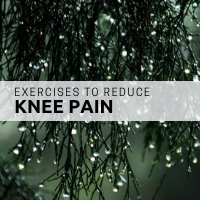08 Mar Exercises to Reduce Knee Pain
 Knee pain is one of the most common types of joint pain, affecting millions of Americans. Knee pain may result from injury, excess weight or a medical condition, such as arthritis. At the Pain Management Group, we focus on ways to reduce knee pain with interventional methods and stretching and exercise. Strengthening the muscles around the knee can help to strengthen and support the knee joint, which can help reduce knee pain.
Knee pain is one of the most common types of joint pain, affecting millions of Americans. Knee pain may result from injury, excess weight or a medical condition, such as arthritis. At the Pain Management Group, we focus on ways to reduce knee pain with interventional methods and stretching and exercise. Strengthening the muscles around the knee can help to strengthen and support the knee joint, which can help reduce knee pain.
Muscles that help support the knee include: quadriceps (front of thigh), hamstrings (back on thigh, abductor (outside thigh), and adductor (inside thigh). Try these simple stretches and exercises to help strengthen these muscles and reduce knee pain. Remember, start slow and listen to your body when starting a new stretch/exercise. It may seem slow at first, but the more frequently you do these exercises, the easier they will become.
Knee stretches
Start with these stretches as a warm-up:
- Chair knee extension: Sitting in a chair, rest your foot on another chair so the knee is slightly raised. Gently push the raised knee toward the floor using only your leg muscles. Hold for 5-10 seconds and release. Repeat 5 times for each leg.
- Heal slide knee extension: Lie on your back, with the left knee bent and left foot flat on the floor. Slowly slide the left heel away from your body so both legs are parallel. Hold for 5-10 seconds, return to starting position. Repeat 5 times on each leg.
- Knee Flexion: Sitting in a chair, loop a long towel under your foot (resting on the floor). Gently pull the towel with both hands to bend the knee, raising your foot 4-5 inches off the floor. Hold for 5-10 seconds, then release. Repeat 5 times on each leg.
- Hamstring stretch: Standing, put your foot in front of you, toes up. With hands on the small of your back (or holding a chair for balance), bend the opposite knee and hip (not your lower back), until you feel the hamstrings stretch. The upper body comes forward at the hip. Hold for 5-10 seconds, then release. Repeat 5 times each leg.
Knee exercises
After you’ve warmed up with the stretches above, do the following exercises to help strengthen your muscles:
- Wall Slide: Leaning with your back against a wall, bend your knees 30 degrees, sliding down the wall, then straighten up again. Move slowly and smoothly, using the wall for balance. Keep feet and legs parallel, and do not allow the knees to go out over the toes. Repeat 5-10 times.
- Bent-Leg Raises: Sitting in a chair, straighten one leg in the air (without locking the knee). Hold for about one minute. Bend your knee to lower the leg about halfway to the floor. Hold for 30 seconds. Return to starting position. Work up to 4 reps each leg (you may need to just start with 1-2 reps and work your way up to 4).
- Abductor Raise: Lie on your side (this may be easier done on a soft surface like your bed or a towel), propped on one elbow. The leg on the floor bent, the other straight. Slowly lift the top leg, hold for 5-10 seconds, then lower. (Ankle weights will increase the intensity). Do 1-3 sets with 12-15 repetitions each leg. Remember to rest in between sets.
- Step ups: Stand in front of a step, like a sturdy bench or stairs, about two feet high (or less if necessary). Step up onto the support, straighten you knees fully (without locking them) and step down. Maintain a steady pace. If you are comfortable with your balance, pump your arms while doing this exercise Start with 30 seconds, slowly building your time. This exercise will get your heart pumping too, helping to increase cardiovascular health.
Use these exercises and stretches to help reduce knee pain and strengthen muscles that support the knees.
*Exercises and stretches credit: American College of Sports Medicine.
 For more information on The Pain Management Group, please visit thepainmanagementgroup.com or schedule an appointment at one of our locations throughout Middle Tennessee.
For more information on The Pain Management Group, please visit thepainmanagementgroup.com or schedule an appointment at one of our locations throughout Middle Tennessee.
We are committed to providing individualized care and vow to treat each patient with compassion and respect, never turning anyone away. Our physicians are fellowship-trained pain specialists who utilize a combination of interventional procedures and medication management services to tailor a personalized care plan for each patient’s long-term pain relief.




